Dancing Migrant Farmworkers’ Experiences
An Interview with Heryka Miranda
BY EMMALY WIEDERHOLT
Heryka Miranda is a dance artist in Hamilton, Ontario, Canada who has been using approaches in expressive arts and dance movement therapy to work with migrant farmworker communities. Alongside Juan Luis Mendoza de la Cruz, she created The Sunflower Man using Indigenous land dance methods to showcase Luis’ experiences as a migrant worker on a sunflower farm in Canada for almost 30 years. Here, Heryka shares her process and some of the unexpected outcomes.
Photo by Deigo Mendez
~~
Can you tell me a little about your own movement/dance history?
I’ve been living in Ontario, Canada for 11 years. Before moving to Canada, I lived in the mid-Atlantic USA – Baltimore, MD and Washington, DC. I was born and raised in White Plains, NY. Dance has always been part of my life, though not necessarily in terms of me going to formal and structured dance classes. Living in a vibrant and predominantly Latino community in White Plains, I lived with people from Mexico, Colombia, Cuba, Dominican Republic and Puerto Rico. Dance was very much a part of my life growing up, especially break dancing. A lot of kids in the neighborhood made opportunities to break dance in the streets and alleys between apartment buildings. We made good use occupying those spaces. These experiences were informal in terms of my appreciation of movement and dance, and were wrapped up in immigrants coming together to celebrate through dance and music.
My family moved from White Plains to Baltimore County when I was 11 or 12 years old. A dance school opened close to my house. It was the first time I’d ever stepped into a dance studio, and I begged my mom and dad for classes. I started there with a lovely Greek woman who taught ballet and jazz. My parents invested in dance classes as much as they could, however, it was expensive and so my dance education was a series of interrupted formal trainings. As a teenager, I was able to take classes through work exchanges with this studio. After high school, I went to community college and became president of the dance company on campus, called Dance Express. I kept finding opportunities to learn dance, and fell in love with modern and contemporary dance.
Dance has always provided me a great sense of pleasure and freedom, as well as a tool to use when feeling sad, anxious, scared and deeply vulnerable. Many times, I would close the door of my bedroom and escape within my own dance. It helped me process and express my emotions with no judgement or pressure to perform or create a tangible dance work. I’ve been a student of expressive arts therapy for many years now, and I had no idea that I was already using approaches in expressive arts as a form of healing as a teenager. When I go back to my old teen diaries, I find poems and bits of writing responding to what I was dealing with through movement.
I identified as a social justice activist as a young adult in response to witnessing some of my family members and Central American and Mexican communities being discriminated against and treated unfairly. I started creating dance pieces as a response to injustices, in particular around immigrant rights or lack thereof and issues around my bicultural identity and feelings of anger, sadness, and my Latina pride.
In terms of genres, I spent a lot of time studying modern dance, Afro Cuban, Afro Brazilian, flamenco and Indigenous dance/theatre. I had incredible teachers in DC and Toronto. In my early 30s, I started to see myself as a professional dancer. My first dance piece in Toronto explored my experiences of being a child of Guatemalan immigrants and the shame I felt for the role that the US government played in the horrific Guatemalan Civil War. It was entitled, ‘Ni Soy de Aqui, Ni Soy de Alla – I’m Neither from Here or There.’
How did you become passionate about working with migrant workers through movement based expressive arts therapy and dance movement therapy?
I was introduced to dance/movement therapy in DC while working with undocumented children and youth through an after-school program. I noticed that, in addition to learning English, they were learning a whole different culture and going through some traumatic experiences. Reading and writing was very difficult for these kids, so I started movement workshops. I ended up using some movement-for-play approaches that I had learned through some creative movement training that I invested in to teach at affluent Montessori schools.
Around that time, I met a dance therapist and became interested in her work. I’d been working with vulnerable communities, including people with disabilities who are non-verbal, and I decided I wanted to pursue dance movement therapy. I moved to Canada and found a school called The CREATE Institute. That’s where I learned about expressive arts therapy, which uses the arts to heal and respond to human suffering. I spent an intensive year in 2008 with the program. It’s a three-year program, but I only did a year because it was very visual arts heavy and I wanted more dance and movement.
The CREATE Institute is where I started to meet gifted practitioners. I met Norma Araiza from the Yaqui nation (located in Sonora, Mexico), who took me under her wings and introduced me to many Indigenous choreographers. One of them was Rulan Tangen from Dancing Earth, who introduced me to the world of land dancing as a method. I started realizing that the origins of dance movement therapy began with First Peoples/Indigenous peoples. I also learned about Anna and Daria Halprin and their movement-based expressive arts therapy method. Through these teachers and practitioners, I could see/feel the healing power from being in direct contact with the land through movement/dance. It’s such ancient medicine and I appreciate that these practitioners of land dance and dance therapy put a language to it. These practices hold embodiment as the leading source of learning; there’s an intermodal quality that honors intuitive imagination and doesn’t impose agendas.
Photo by Diego Mendez
I was going to move to Boston to study dance movement therapy, but my husband got sick, so I ended up staying in Canada and going to Brock University to do a research program in the field of Applied Health Sciences. My supervisor was really supportive of my interest in movement-based therapy and land dance.
In close proximity to the university were migrant farm workers. A dear friend of mine, Evelyn Encalada, had been working with migrant farm workers as a community organizer and researcher for over 15 years. She introduced me to my migrant farm worker neighbors from Guatemala and Mexico. She took me to a residence and introduced me as the woman who does healing with dance. I did an impromptu movement session that explored elements on a day in the life of migrant women. There was something about that experience that really hit my heart and took me back to similar work I had done with Mexican and Central American immigrants in DC.
I ended up building relationships with various migrant farm workers. One man in particular who I became very close to was Juan Luis Mendoza de la Cruz, who had been coming to Canada to work as a farm worker for 28 years. I also became very good friends with an Anglican priest from Colombia, Padre Javier Arias. He had started a mission at his Anglican church in the Niagara region to find creative endeavors to integrate migrant farm workers into their rural host community as a way to lessen isolation and loneliness. His church became a hub for the predominantly Spanish speaking migrant farm worker community as it provided a variety of supports and services to them. Padre Javier was interested in working with me, as he was always looking for people to work creatively with migrant workers to not only integrate the workers into the community but also to find ways to alleviate stress and anxiety.
I introduced myself to migrant workers as a dance artist and grad student who was conscientious of the hardships involved in forced migrations and the lived experiences of family separation who wanted to bring dance arts to migrant worker communities as a medium to tell stories through the body, alleviate stress, and build community. When I met Luis, he asked me: What do you mean when you say that we can tell stories through the body? Instead of explaining to him and other workers, I showed them. It was again an impromptu experience in the moment at the church space with a group of migrant farm workers. I became close to many of the migrant workers and did four workshops at the church with a mixed gendered group of migrant workers. I did another four workshops with a group of Mexican men at their residence at a grape farm. I did two longer workshops with migrant women, and for those workshops I was able to use the dance studio space at my university and arrange for transportation.
What did your practice with the migrant workers look like?
It was very interesting. Sometimes I only had between 15 to 45 minutes with them. I didn’t know what space would be available or who would come. I would start with a warm up that would include a head to toe body scan with breathing. Then I would ask them to share a body part they use in relation to the work they do. Strawberry pickers, for example, would show me their knees. Workers would also commonly show me their elbows, fingers, hands and wrists. They told me: “We don’t get to show this to people; we’re not allowed to say we’re in pain because we’re easily disposable.” In our workshops, the need came from them: Was there a place in the body that needed some extra love and care? Then I would ask them to, for example, give their knee a sound. At first it was weird and awkward, but they were very trusting and went there with me.
Because so many of the workers are far from their families for eight to 10 months a year, we would create friction with our bodies, starting with our hands and placing our hands on our hearts, to create an imaginary fire and blow the smoke as a wish to loved ones. We used these physical metaphors to send messages to husbands, wives and children. Then we would take those wishes and create tableaus of meaning. Finally, I would ask them: If they could give the tableau a name or a title, what would it be?
The workshops really depended on where it took place. Some spaces were not big enough. If it was a nice day, we would go outside. Evening was the only time available for the grape farm workers because they had to work during the day.
Photo by Farrah Miranda
With the migrant women, I was able to have two hours with them, but only for two sessions. I was able to use the university, which was huge. Many had never been to a university or a dance studio before. We started with a body scan and breathing. I then asked them: “Who are you?” They responded through words or movements. They would say something like, “I am Ariana, the woman of the shooting star.” Ariana shared that she’s the woman of the shooting star because, by sending money home to her family, she’s able to make the wishes of her family come true despite having horrible back pain and arthritis in her wrists. We ended up creating a short dance to show the work she does and how it makes her feel.
All the participants were able to work on their own short pieces and then share in pairs with each other. This is when I started to understand the importance of witnessing. Being seen brought subjectivity and meaning back into the women’s lives. We explored what it means to feel lonely and witness that. A lot of the women said they felt weak by allowing their isolation to dominate their feelings. It was something they felt they needed to conquer. I felt like they were punishing themselves for being human, but they felt like they were the lucky ones because they had jobs. They told me: “Here we are with the opportunity to send money back, so we just need to suck it up.” It was interesting to see them go through that, and then cry and show how devastating it feels to be away from loved ones, including children who aren’t even two or three years old.
I found the movement based expressive arts framework as an important tool, but I had no expectation to create a performance piece. I just honored the process of the framework and allowed the participants to give emotion a voice and a shape. Each time I was with them was very different. For example, I could only do two sessions with the women at the university because their work was really unpredictable. After the second Saturday, they messaged me that they couldn’t continue because they now had to work on Saturdays.
Can you tell me a little about how The Sunflower Man came about and the different ways it’s been shared?
While I was facilitating the dance sessions with the workers, I was also working with Juan Luis Mendoza de la Cruz. I met with Luis every Sunday in August 2015. I would go to his farm and spend two to three hours in the sunflower fields with him. He would tell me about the lifecycle of the sunflowers, as well as show me the various work he does to care for them. I told him that he, along with the other migrant workers, create works of art in the sunflower fields. He loved that I described him and his co-workers as artists.
Little by little, I invited actions: shoes off, walking through the field, looking up at the horizon, embracing the sweat on his skin from the hot sun, caressing the sunflowers, melting bare feet into the wet soil, etc. I suggested he walk barefoot on the soil he tills every day, on his only day off. The first time he took off his shoes and socks, he was shocked as he had never walked barefoot on Canadian soil in his 20+ years working on the farm. I asked him what he loved about working in the sunflower field, and he responded that he gets to see the sunrise at every morning. He gets to see Mother Earth being born every day. I asked him to show me that with his body, so he raised both of his arms up and then brought his arms into an embrace. We explored different types of metaphors. I would ask him how he felt with the sun on his face, since he works during the hottest temperatures. He said it feels good to sweat. The sweat from his skin was something we used as inspiration for movement. He would move the sweat from his face, move it down across his body, and it became sensual through touch. There was a spiritual sense of reciprocity that became more evident between the relationship he has with the sunflowers: As he takes care of the sunflowers, they take care of him.
Photo by Heryka Miranda
I had an opportunity to perform with Luis at a local arts festival in April 2016. I worked with him through August 2015 and, when he came back in February 2016, I worked with him again until April when we performed our 15-minute dance at the festival. Not only is Luis a knowledgeable and expert in the field of farming, but he always wanted to be a dancer. He never took formal classes, but he always loved dance. He taught himself the guitar, as well as sings and writes poetry. He’s such a multi-talented and detail-oriented man. The impetus for him performing with me, he admitted, was that he didn’t want to be another worker who goes unnoticed. He said, “If you think dance can give me hope, then I’m open.” When I met him, he was going through a difficult time. He had just turned 50 and felt unsure about how much longer he could work. He told me that dancing and moving his body in a different way besides working on the farm was life changing.
Around that time, I happened to meet a filmmaker, Monica Gutierrez, who came and documented the work I was doing with Luis. There was no funding for any of us, and she didn’t live in the region. She drove up from Toronto to take footage. At the festival performance, she took more footage and interviewed us.
There was a write-up about our dance piece in a local newspaper, and a member of Parliament read it and sent us an invitation to present The Sunflower Man at Parliament Hill in October 2016. Unfortunately, Luis had to leave back to Mexico before the date. He became determined to stay, and Monica would check in with us about his progress. The Mexican Consulate denied him a tourist visa two times. Finally, the Parliament member who had invited us wrote a letter of invitation requesting Luis’ presence at a forum and Luis was able to get a tourist visa to stay to participate in the forum. Him getting this type of visa was unheard of. We went to Parliament to perform, and Monica came with us again. From all that footage, she created The Sunflower Man film and has shown it at several festivals. Both Luis and I have been able to come to a couple showings.
This whole experience was unexpected. It showed me how powerful the tool of dance for social justice is. I could see the changes in Luis. He used rehearsals and performances as a form of resistance to precarity, as an opportunity to bring visibility to the lives of migrant farm workers, and as a way to advocate for migrant justice. “Canada owes me something,” he would say. We presented our dance piece in Parliament, and then he was able to speak at Parliament Hill and say to lawmakers that Canada owes migrant farmworkers permanent residency status and a path to citizenship.
Through your work, have you noticed any shifts in awareness or attitudes, either in the migrant workers themselves or in the public?
The work with Luis continues. We’re going to Concordia University in April 2019 to present the piece again. We’ve received many invitations and he is often unavailable. One time we showed the film and he was able to Skype in from Mexico.
Through the work I did with grape farmworkers, I was able to collaborate with another artist named Farrah Miranda. She was inspired by my work with Luis, so she hired me as a choreographer to facilitate land dancing sessions with grape workers. We made a piece called Speaking Fruit, an installation using a trailer converted into a fruit market. There are messages on the fruits gathered from various migrant farmworkers in the Niagara Region. Inside the trailer is a virtual reality video that captures the grape workers interacting with various grape plants in the vineyard through movement/dance and music. Many of the grape farm workers happen to be musicians, so their music was also recorded and used as part of the soundscape for the short film.
How would you like to expand your work next?
I would like to apprentice with Rulan Tangen from Dancing Earth and learn more about the methodology that she uses as a creator and choreographer who uses land dance. I am hoping to work with her in the Spring/Summer 2019. I am very interested in building my repertoire in providing accessible and inclusive dance facilitation with systemically vulnerable communities. In the meantime, I am teaching my first university course at Brock University called The Arts In and Across the Curriculum that focuses on using dance and drama strategies/choreographic forms and elements of dance as tools for learning. I am working with adults with disabilities on a research project using arts-based inquiry methods, including movement based, expressive arts therapeutic approaches to explore their life aspirations and the various ways in which they would like to contribute to their local communities, among other life interests. I am also writing a chapter about The Sunflower Man as part of an anthology book project for artists of color who have Indigenous heritage. I’m very excited about these opportunities and seeing where this work can continue and expand.
Photo by Teni Brant
~~

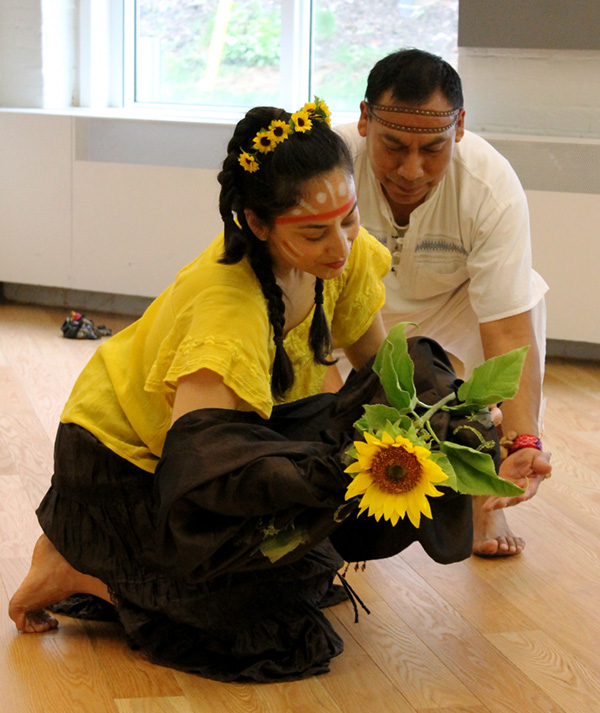
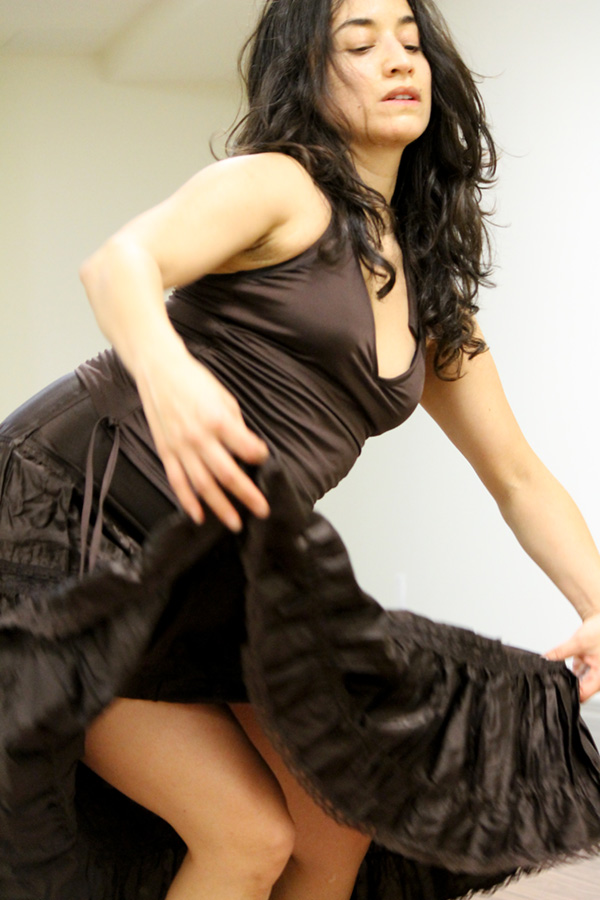
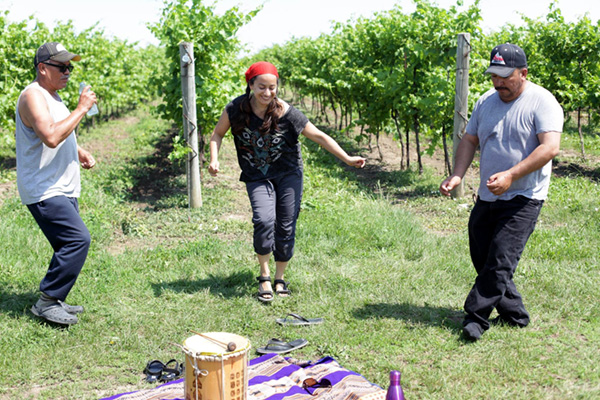
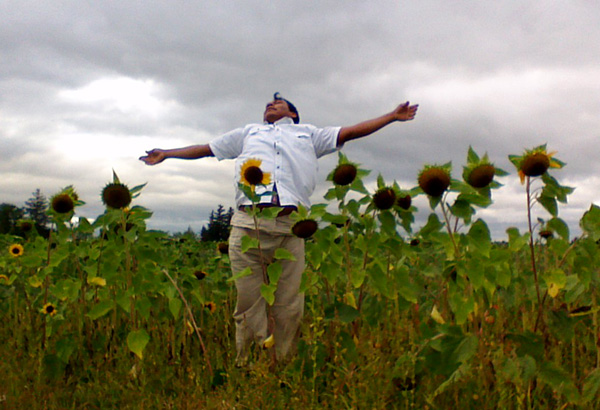
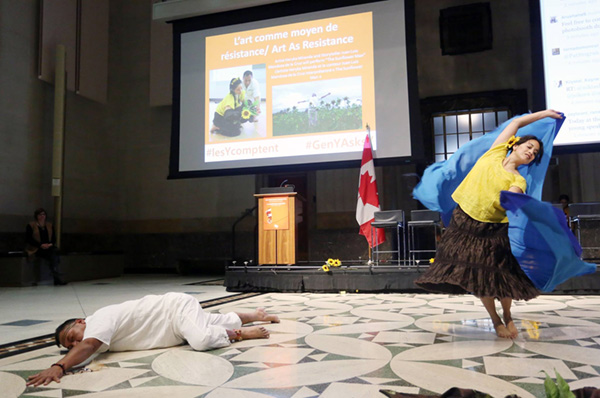
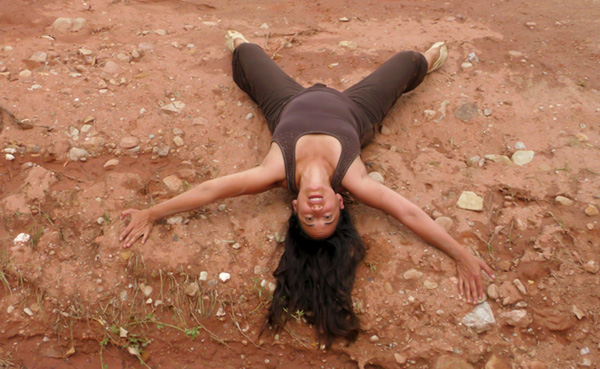
4 Responses to “Dancing Migrant Farmworkers’ Experiences”
Absolutely beautiful work! It’s so important. Thank you.
You have always brought us great joy and inspiration. This article is amazing and speaks to so much of how you and the dancers are changing the world to be a place where all are welcome, respected and loved, knowing that they are gifted and truly belong. Thank you for BEING the light that you ARE, healing all through the joy of dance. Many blessings in the spirit of ubuntu
Thanks Romy!
Breathtakingly beautiful….thank you
<3
Comments are closed.